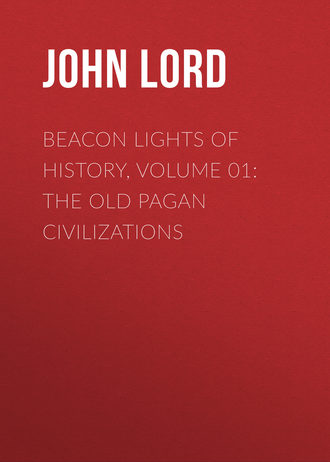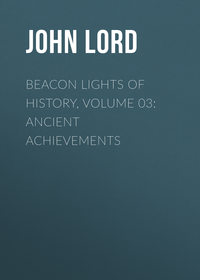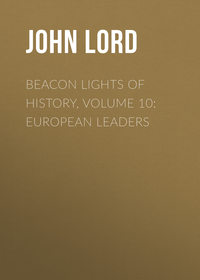 полная версия
полная версияBeacon Lights of History, Volume 01: The Old Pagan Civilizations
Phidias also executed various other works,–all famous in his day,–which have, however, perished; but many executed under his superintendence still remain, and are universally admired for their grace and majesty of form. The great master himself was probably vastly superior to any of his disciples, and impressed his genius on the age, having, so far as we know, no rival among his contemporaries, as he has had no successor among the moderns of equal originality and power, unless it be Michael Angelo. His distinguished excellence was simplicity and grandeur; and he was to sculpture what Aeschylus was to tragic poetry,–sublime and grand, representing ideal excellence, Though his works have perished, the ideas he represented still live. His fame is immortal, though we know so little about him. It is based on the admiration of antiquity, on the universal praise which his creations extorted even from the severest critics in an age of Art, when the best energies of an ingenious people were directed to it with the absorbing devotion now given to mechanical inventions and those pursuits which make men rich and comfortable. It would be interesting to know the private life of this great artist, his ardent loves and fierce resentments, his social habits, his public honors and triumphs,–but this is mere speculation. We may presume that he was rich, flattered, and admired,–the companion of great statesmen, rulers, and generals; not a persecuted man like Dante, but honored like Raphael; one of the fortunate of earth, since he was a master of what was most valued in his day.
But it is the work which he represents–and still more comprehensively Art itself in the ancient world–to which I would call your attention, especially the expression of Art in buildings, in statues, and in pictures.
"Art" is itself a very great word, and means many things; it is applied to style in writing, to musical compositions, and even to effective eloquence, as well as to architecture, sculpture, and painting. We speak of music as artistic,–and not foolishly; of an artistic poet, or an artistic writer like Voltaire or Macaulay; of an artistic preacher,–by which we mean that each and all move the sensibilities and souls and minds of men by adherence to certain harmonies which accord with fixed ideas of grace, beauty, and dignity. Eternal ideas which the mind conceives are the foundation of Art, as they are of Philosophy. Art claims to be creative, and is in a certain sense inspired, like the genius of a poet. However material the creation, the spirit which gives beauty to it is of the mind and soul. Imagination is tasked to its utmost stretch to portray sentiments and passions in the way that makes the deepest impression. The marble bust becomes animated, and even the temple consecrated to the deity becomes religious, in proportion as these suggest the ideas and sentiments which kindle the soul to admiration and awe. These feelings belong to every one by nature, and are most powerful when most felicitously called out by the magic of the master, who requires time and labor to perfect his skill. Art is therefore popular, and appeals to every one, but to those most who live in the great ideas on which it is based. The peasant stands awe-struck before the majestic magnitude of a cathedral; the man of culture is roused to enthusiasm by the contemplation of its grand proportions, or graceful outlines, or bewitching details, because he sees in them the realization of his ideas of beauty, grace, and majesty, which shine forever in unutterable glory,–indestructible ideas which survive all thrones and empires, and even civilizations. They are as imperishable as stars and suns and rainbows and landscapes, since these unfold new beauties as the mind and soul rest upon them. Whenever, then, man creates an image or a picture which reveals these eternal but indescribable beauties, and calls forth wonder or enthusiasm, and excites refined pleasures, he is an artist. He impresses, to a greater or less degree, every order and class of men. He becomes a benefactor, since he stimulates exalted sentiments, which, after all, are the real glory and pride of life, and the cause of all happiness and virtue,–in cottage or in palace, amid hard toils as well as in luxurious leisure. He is a self-sustained man, since he revels in ideas rather than in praises and honors. Like the man of virtue, he finds in the adoration of the deity he worships his highest reward. Michael Angelo worked preoccupied and rapt, without even the stimulus of praise, to advanced old age, even as Dante lived in the visions to which his imagination gave form and reality. Art is therefore not only self-sustained, but lofty and unselfish. It is indeed the exalted soul going forth triumphant over external difficulties, jubilant and melodious even in poverty and neglect, rising above all the evils of life, revelling in the glories which are impenetrable, and living–for the time–in the realm of deities and angels. The accidents-of earth are no more to the true artist striving to reach and impersonate his ideal of beauty and grace, than furniture and tapestries are to a true woman seeking the beatitudes of love. And it is only when there is this soul longing to reach the excellence conceived, for itself alone, that great works have been produced. When Art has been prostituted to pander to perverted tastes, or has been stimulated by thirst for gain, then inferior works only have been created. Fra Angelico lived secluded in a convent when he painted his exquisite Madonnas. It was the exhaustion of the nervous energies consequent on superhuman toils, rather than the luxuries and pleasures which his position and means afforded, which killed Raphael at thirty-seven.
The artists of Greece did not live for utilities any more than did the Ionian philosophers, but in those glorious thoughts and creations which were their chosen joy. Whatever can be reached by the unaided powers of man was attained by them. They represented all that the mind can conceive of the beauty of the human form, and the harmony of architectural proportions, In the realm of beauty and grace modern civilization has no prouder triumphs than those achieved by the artists of Pagan antiquity. Grecian artists have been the teachers of all nations and all ages in architecture, sculpture, and painting. How far they were themselves original we cannot tell. We do not know how much they were indebted to Egyptians, Phoenicians, and Assyrians, but in real excellence they have never been surpassed. In some respects, their works still remain objects of hopeless imitation: in the realization of ideas of beauty and form, they reached absolute perfection. Hence we have a right to infer that Art can flourish under Pagan as well as Christian influences. It was a comparatively Pagan age in Italy when the great artists arose who succeeded Da Vinci, especially under the patronage of the Medici and the Medicean popes. Christianity has only modified Art by purifying it from sensual attractions. Christianity added very little to Art, until cathedrals arose in their grand proportions and infinite details, and until artists sought to portray in the faces of their Saints and Madonnas the seraphic sentiments of Christian love and angelic purity. Art even declined in the Roman world from the second century after Christ, in spite of all the efforts of Christian emperors. In fact neither Christianity nor Paganism creates it; it seems to be independent of both, and arises from the peculiar genius and circumstances of an age. Make Art a fashion, honor and reward it, crown its great masters with Olympic leaves, direct the energies of an age or race upon it, and we probably shall have great creations, whether the people are Christian or Pagan. So that Art seems to be a human creation, rather than a divine inspiration. It is the result of genius, stimulated by circumstances and directed to the contemplation of ideal excellence.
Much has been written on those principles upon which Art is supposed to be founded, but not very satisfactorily, although great learning and ingenuity have been displayed. It is difficult to conceive of beauty or grace by definitions,–as difficult as it is to define love or any other ultimate sentiment of the soul. "Metaphysics, mathematics, music, and philosophy," says Cleghorn, "have been called in to analyze, define, demonstrate, or generalize," Great critics, like Burke, Alison, and Stewart, have written interesting treatises on beauty and taste. "Plato represents beauty as the contemplation of the mind. Leibnitz maintained that it consists in perfection. Diderot referred beauty to the idea of relation. Blondel asserted that it was in harmonic proportions. Leigh speaks of it as the music of the age." These definitions do not much assist us. We fall back on our own conceptions or intuitions, as probably did Phidias, although Art in Greece could hardly have attained such perfection without the aid which poetry and history and philosophy alike afforded. Art can flourish only as the taste of the people becomes cultivated, and by the assistance of many kinds of knowledge. The mere contemplation of Nature is not enough. Savages have no art at all, even when they live amid grand mountains and beside the ever-changing sea. When Phidias was asked how he conceived his Olympian Jove, he referred to Homer's poems. Michael Angelo was enabled to paint the saints and sibyls of the Sistine Chapel from familiarity with the writings of the Jewish prophets. Isaiah inspired him as truly as Homer inspired Phidias. The artists of the age of Phidias were encouraged and assisted by the great poets, historians, and philosophers who basked in the sunshine of Pericles, even as the great men in the Court of Elizabeth derived no small share of their renown from her glorious appreciation. Great artists appear in clusters, and amid the other constellations that illuminate the intellectual heavens. They all mutually assist each other. When Rome lost her great men, Art declined. When the egotism of Louis XIV. extinguished genius, the great lights in all departments disappeared. So Art is indebted not merely to the contemplation of ideal beauty, but to the influence of great ideas permeating society,–such as when the age of Phidias was kindled with the great thoughts of Socrates, Democritus, Thucydides, Euripides, Aristophanes, and others, whether contemporaries or not; a sort of Augustan or Elizabethan age, never to appear but once among the same people.
Now, in reference to the history or development of ancient Art, until it culminated in the age of Pericles, we observe that its first expression was in architecture, and was probably the result of religious sentiments, when nations were governed by priests, and not distinguished for intellectual life. Then arose the temples of Egypt, of Assyria, of India. They are grand, massive, imposing, but not graceful or beautiful. They arose from blended superstition and piety, and were probably erected before the palaces of kings, and in Egypt by the dynasty that builded the older pyramids. Even those ambitious and prodigious monuments, which have survived every thing contemporaneous, indicate the reign of sacerdotal monarchs and artists who had no idea of beauty, but only of permanence. They do not indicate civilization, but despotism,–unless it be that they were erected for astronomical purposes, as some maintain, rather than as sepulchres for kings. But this supposition involves great mathematical attainments. It is difficult to conceive of such a waste of labor by enlightened princes, acquainted with astronomical and mathematical knowledge and mechanical forces, for Herodotus tells us that one hundred thousand men toiled on the Great Pyramid during forty years. What for? Surely it is hard to suppose that such a pile was necessary for the observation of the polar star; and still less probably was it built as a sepulchre for a king, since no covered sarcophagus has ever been found in it, nor have even any hieroglyphics. The mystery seems impenetrable.
But the temples are not mysteries. They were built also by sacerdotal monarchs, in honor of the deity. They must have been enormous, perhaps the most imposing ever built by man: witness the ruins of Karnac–a temple designated by the Greeks as that of Jupiter Ammon–with its large blocks of stone seventy feet in length, on a platform one thousand feet long and three hundred wide, its alleys over a mile in length lined with colossal sphinxes, and all adorned with obelisks and columns, and surrounded with courts and colonnades, like Solomon's temple, to accommodate the crowds of worshippers as well as priests. But these enormous structures were not marked by beauty of proportion or fitness of ornament; they show the power of kings, not the genius of a nation. They may have compelled awe; they did not kindle admiration. The emotion they called out was such as is produced now by great engineering exploits, involving labor and mechanical skill, not suggestive of grace or harmony, which require both taste and genius. The same is probably true of Solomon's temple, built at a much later period, when Art had been advanced somewhat by the Phoenicians, to whose assistance it seems he was much indebted. We cannot conceive how that famous structure should have employed one hundred and fifty thousand men for eleven years, and have cost what would now be equal to $200,000,000, from any description which has come down to us, or any ruins which remain, unless it were surrounded by vast courts and colonnades, and ornamented by a profuse expenditure of golden plates,–which also evince both power and money rather than architectural genius.
After the erection of temples came the building of palaces for kings, equally distinguished for vast magnitude and mechanical skill, but deficient in taste and beauty, showing the infancy of Art. Yet even these were in imitation of the temples. And as kings became proud and secular, probably their palaces became grander and larger,–like the palaces of Nebuchadnezzar and Rameses the Great and the Persian monarchs at Susa, combining labor, skill, expenditure, dazzling the eye by the number of columns and statues and vast apartments, yet still deficient in beauty and grace.
It was not until the Greeks applied their wonderful genius to architecture that it became the expression of a higher civilization. And, as among Egyptians, Art in Greece is first seen in temples; for the earlier Greeks were religious, although they worshipped the deity under various names, and in the forms which their own hands did make.
The Dorians, who descended from the mountains of northern Greece, eighty years after the fall of Troy, were the first who added substantially to the architectural art of Asiatic nations, by giving simplicity and harmony to their temples. We see great thickness of columns, a fitting proportion to the capitals, and a beautiful entablature. The horizontal lines of the architrave and cornice predominate over the vertical lines of the columns. The temple arises in the severity of geometrical forms. The Doric column was not entirely a new creation, but was an improvement on the Egyptian model,–less massive, more elegant, fluted, increasing gradually towards the base, with a slight convexed swelling downward, about six diameters in height, superimposed by capitals. "So regular was the plan of the temple, that if the dimensions of a single column and the proportion the entablature should bear to it were given to two individuals acquainted with this style, with directions to compose a temple, they would produce designs exactly similar in size, arrangement, and general proportions." And yet while the style of all the Doric temples is the same, there are hardly two temples alike, being varied by the different proportions of the column, which is the peculiar mark of Grecian architecture, even as the arch is the feature of Gothic architecture. The later Doric was less massive than the earlier, but more rich in sculptured ornaments. The pedestal was from two thirds to a whole diameter of a column in height, built in three courses, forming as it were steps to the platform on which the pillar rested. The pillar had twenty flutes, with a capital of half a diameter, supporting the entablature. This again, two diameters in height, was divided into architrave, frieze, and cornice. But the great beauty of the temple was the portico in front,–a forest of columns, supporting the pediment above, which had at the base an angle of about fourteen degrees. From the pediment the beautiful cornice projects with various mouldings, while at the base and at the apex are sculptured monuments representing both men and animals. The graceful outline of the columns, and the variety of light and shade arising from the arrangement of mouldings and capitals, produced an effect exceedingly beautiful. All the glories of this order of architecture culminated in the Parthenon,–built of Pentelic marble, resting on a basement of limestone, surrounded with forty-eight fluted columns of six feet and two inches diameter at the base and thirty-four feet in height, the frieze and pediment elaborately ornamented with reliefs and statues, while within the cella or interior was the statue of Minerva, forty feet high, built of gold and ivory. The walls were decorated with the rarest paintings, and the cella itself contained countless treasures. This unrivalled temple was not so large as some of the cathedrals of the Middle Ages, but it covered twelve times the ground of the temple of Solomon, and from the summit of the Acropolis it shone as a wonder and a glory. The marbles have crumbled and its ornaments have been removed, but it has formed the model of the most beautiful buildings of the world, from the Quirinus at Rome to the Madeleine at Paris, stimulating alike the genius of Michael Angelo and Christopher Wren, immortal in the ideas it has perpetuated, and immeasurable in the influence it has exerted. Who has copied the Flavian amphitheatre except as a convenient form for exhibitors on the stage, or for the rostrum of an orator? Who has not copied the Parthenon as the severest in its proportions for public buildings for civic purposes?
The Ionic architecture is only a modification of the Doric,–its columns more slender and with a greater number of flutes, and capitals more elaborate, formed with volutes or spiral scrolls, while its pediment, the triangular facing of the portico, is formed with a less angle from the base,–the whole being more suggestive of grace than strength. Vitruvius, the greatest authority among the ancients, says that "the Greeks, in inventing these two kinds of columns, imitated in the one the naked simplicity and aspects of a man, and in the other the delicacy and ornaments of a woman, whose ringlets appear in the volutes of the capital."
The Corinthian order, which was the most copied by the Romans, was still more ornamented, with foliated capitals, greater height, and a more decorated entablature.
But the principles of all these three orders are substantially the same,–their beauty consisting in the column and horizontal lines, even as vertical lines marked the Gothic. We see the lintel and not the arch; huge blocks of stone perfectly squared, and not small stones irregularly laid; external rather than internal pillars, the cella receiving light from the open roof above, rather than from windows; a simple outline uninterrupted,–generally in the form of a parallelogram,–rather than broken by projections. There is no great variety; but the harmony, the severity, and beauty of proportion will eternally be admired, and can never be improved,–a temple of humanity, cheerful, useful, complete, not aspiring to reach what on earth can never be obtained, with no gloomy vaults speaking of maceration and grief, no lofty towers and spires soaring to the sky, no emblems typical of consecrated sentiments and of immortality beyond the grave, but rich in ornaments drawn from the living world,–of plants and animals, of man in the perfection of physical strength, of woman in the unapproachable loveliness of grace of form. As the world becomes pagan, intellectual, thrifty, we see the architecture of the Greeks in palaces, banks, halls, theatres, stores, libraries; when it is emotional, poetic, religious, fervent, aspiring, we see the restoration of the Gothic in churches, cathedrals, schools,–for Philosophy and Art did all they could to civilize the world before Christianity was sent to redeem it and prepare mankind for the life above. Such was the temple of the Greeks, reappearing in all the architectures of nations, from the Romans to our own times,–so perfect that no improvements have subsequently been made, no new principles discovered which were not known to Vitruvius. What a creation, to last in its simple beauty for more than two thousand years, and forever to remain a perfect model of its kind! Ah, that was a triumph of Art, the praises of which have been sung for more than sixty generations, and will be sung for hundreds yet to come. But how hidden and forgotten the great artists who invented all this, showing the littleness of man and the greatness of Art itself. How true that old Greek saying, "Life is short, but Art is long."
But the genius displayed in sculpture was equally remarkable, and was carried to the same perfection. The Greeks did not originate sculpture. We read of sculptured images from remotest antiquity. Assyria, Egypt, and India are full of relics. But these are rude, unformed, without grace, without expression, though often colossal and grand. There are but few traces of emotion, or passion, or intellectual force. Everything which has come down from the ancient monarchies is calm, impassive, imperturbable. Nor is there a severe beauty of form. There is no grace, no loveliness, that we should desire them. Nature was not severely studied. We see no aspiration after what is ideal. Sometimes the sculptures are grotesque, unnatural, and impure. They are emblematic of strange deities, or are rude monuments of heroes and kings. They are curious, but they do not inspire us. We do not copy them; we turn away from them. They do not live, and they are not reproduced. Art could spare them all, except as illustrations of its progress. They are merely historical monuments, to show despotism and superstition, and the degradation of the people.
But this cannot be said of the statues which the Greeks created, or improved from ancient models. In the sculptures of the Greeks we see the utmost perfection of the human form, both of man and woman, learned by the constant study of anatomy and of nude figures of the greatest beauty. A famous statue represented the combined excellences of perhaps one hundred different persons. The study of the human figure became a noble object of ambition, and led to conceptions of ideal grace and loveliness such as no one human being perhaps ever possessed in all respects. And not merely grace and beauty were thus represented in marble or bronze, but dignity, repose, majesty. We see in those figures which have survived the ravages of time suggestions of motion, rest, grace, grandeur,–every attitude, every posture, every variety of form. We see also every passion which moves the human soul,–grief, rage, agony, shame, joy, peace. But it is the perfection of form which is most wonderful and striking. Nor did the artists work to please the vulgar rich, but to realize their own highest conceptions, and to represent sentiments in which the whole nation shared. They sought to instruct; they appealed to the highest intelligence. "Some sought to represent tender beauty, others daring power, and others again heroic grandeur." Grecian statuary began with ideal representations of deities; then it produced the figures of gods and goddesses in mortal forms; then the portrait-statues of distinguished men. This art was later in its development than architecture, since it was directed to ornamenting what had already nearly reached perfection. Thus Phidias ornamented the Parthenon in the time of Pericles, when sculpture was purest and most ideal In some points of view it declined after Phidias, but in other respects it continued to improve until it culminated in Lysippus, who was contemporaneous with Alexander. He is said to have executed fifteen hundred statues, and to have displayed great energy of execution. He idealized human beauty, and imitated Nature to the minutest details. He alone was selected to make the statue of Alexander, which is lost. None of his works, which were chiefly in bronze, are extant; but it is supposed that the famous Hercules and the Torso Belvedere are copies from his works, since his favorite subject was Hercules. We only can judge of his great merits from his transcendent reputation and the criticism of classic writers, and also from the works that have come down to us which are supposed to be imitations of his masterpieces. It was his scholars who sculptured the Colossus of Rhodes, the Laocoön, and the Dying Gladiator. After him plastic art rapidly degenerated, since it appealed to passion, especially under Praxiteles, who was famous for his undraped Venuses and the expression of sensual charms. The decline of Art was rapid as men became rich, and Epicurean life was sought as the highest good. Skill of execution did not decline, but ideal beauty was lost sight of, until the art itself was prostituted–as among the Romans–to please perverted tastes or to flatter senatorial pride.









